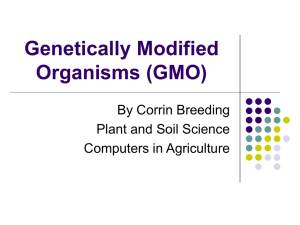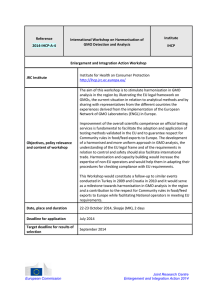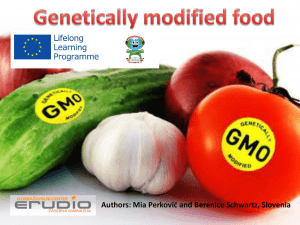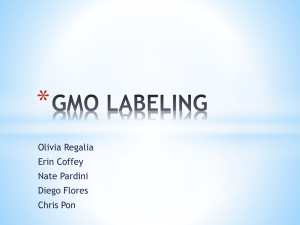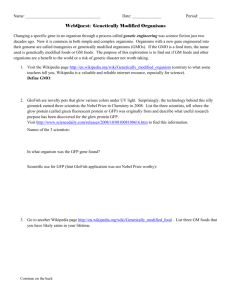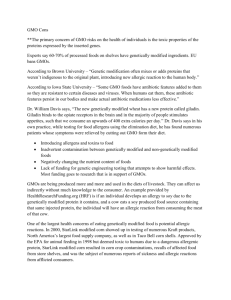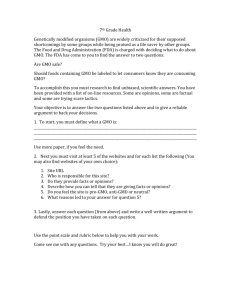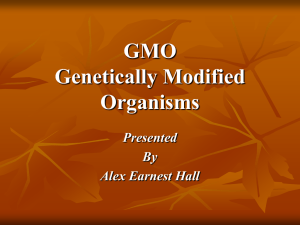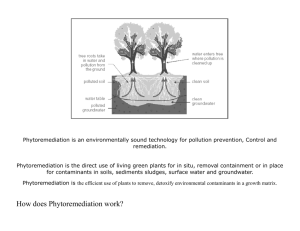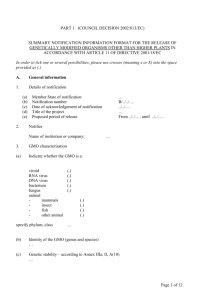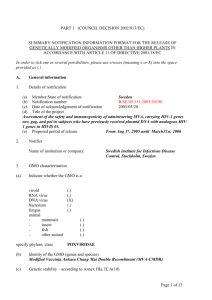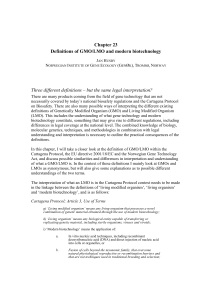ITT Dublin RE_7 Form
advertisement
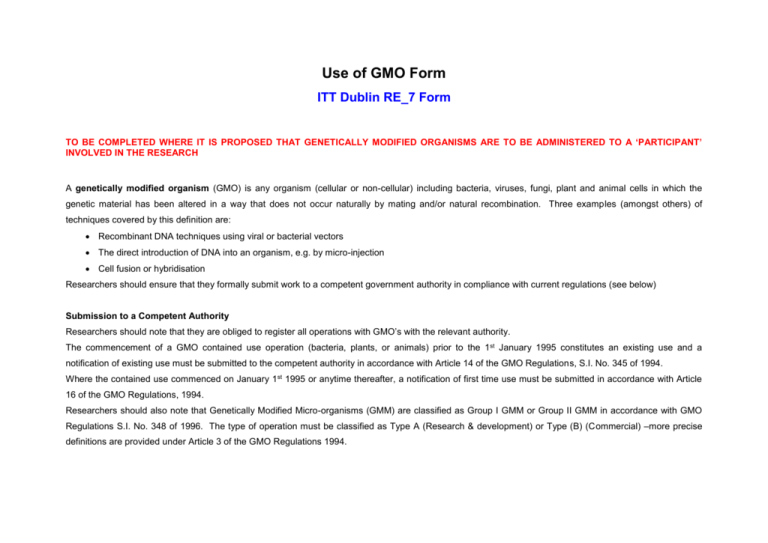
Use of GMO Form ITT Dublin RE_7 Form TO BE COMPLETED WHERE IT IS PROPOSED THAT GENETICALLY MODIFIED ORGANISMS ARE TO BE ADMINISTERED TO A ‘PARTICIPANT’ INVOLVED IN THE RESEARCH A genetically modified organism (GMO) is any organism (cellular or non-cellular) including bacteria, viruses, fungi, plant and animal cells in which the genetic material has been altered in a way that does not occur naturally by mating and/or natural recombination. Three examples (amongst others) of techniques covered by this definition are: Recombinant DNA techniques using viral or bacterial vectors The direct introduction of DNA into an organism, e.g. by micro-injection Cell fusion or hybridisation Researchers should ensure that they formally submit work to a competent government authority in compliance with current regulations (see below) Submission to a Competent Authority Researchers should note that they are obliged to register all operations with GMO’s with the relevant authority. The commencement of a GMO contained use operation (bacteria, plants, or animals) prior to the 1st January 1995 constitutes an existing use and a notification of existing use must be submitted to the competent authority in accordance with Article 14 of the GMO Regulations, S.I. No. 345 of 1994. Where the contained use commenced on January 1st 1995 or anytime thereafter, a notification of first time use must be submitted in accordance with Article 16 of the GMO Regulations, 1994. Researchers should also note that Genetically Modified Micro-organisms (GMM) are classified as Group I GMM or Group II GMM in accordance with GMO Regulations S.I. No. 348 of 1996. The type of operation must be classified as Type A (Research & development) or Type (B) (Commercial) –more precise definitions are provided under Article 3 of the GMO Regulations 1994. Genetically Modified Organism (GMO) Risk Assessment Sheet Researcher’s Name: (use block capitals) Title: School/Department/Centre: Location of Work Title of Study: Description of Work Give brief details of task, materials and equipment, frequency and duration. Continue on separate sheet if necessary or attach method statement, protocol etc. STAGE 1: Compliance with GMO Regulations Has the relevant Competent Authority been notified of the work with the GMO? Tick one only Yes No Yes No Yes No If yes: Name of Competent Authority: Has the work been approved by Competent Authority? Tick one only If not yet approved, what is the expected date of approval? Give Date: What is the expected start date of the work with the GMO? Give Date: Copies of documentation indicating approval for commencement of work should be supplied with this form. If no: Name of Competent Authority to which the application is to be made: Has the work been approved by Competent Authority? When is the submission to be made? Tick one only Give Date: What is the expected approval date? Give Date: What is the expected start date of the work with the GMO? Give Date: The Research Ethics Committee must be notified when the approval for commencement of work becomes available. STAGE 2: Classification of Genetically Modified Organism Name(s) of organism(s): Group I or II Characteristics Capacity to survive, establish, disseminate and/or displace other organisms / plants / animals Pathogenicity to plants and/or animals Potential for transfer of genetic material between GMO and other organisms Products of gene expression that could be toxic to other organisms/plants/animals Phenotypic and genetic stability Potential to cause other harm to target or non-target organisms/plants/animals (specify what sort of harm) Capacity to survive, establish, disseminate and/or displace other organisms / plants / animals Pathogenicity to plants and/or animals Potential for transfer of genetic material between GMO and other organisms Products of gene expression that could be toxic to other organisms/plants/animals Phenotypic and genetic stability Potential to cause other harm to target or non-target organisms/plants/animals (specify what sort of harm) 1 REF 2 HAZARD/CONSEQUENCE Hazards of biological used, blood borne infection; skin sensitisation; sensitisation by inhalation; toxic by ingestion or inhalation, products, intermediates etc. Injuries that could occur and how? Who is at risk? Physical or mental conditions that may alter the risk? e.g. pregnancy; illness (specify); disability (specify); height, etc. 3 CONTROLS Laboratory containment level - specify level (1-4): Safe work practices, personal protective equipment (ppe), signs, warnings, alarms, training, etc. Environmental controls (specify types): exhaust ventilation; safety or fume cupboards; limited access to work area; protective clothing; respiratory protection; information; supervision; monitoring and control Arrangements for disinfection and disposal methods of samples, contaminated materials, sharps etc. Further control measures to be considered e.g. use of more extensively disabled host; enclose process etc. 4 Frequency Assessment completed by: Print Name: Signature: Date: Approved by Head of Dept./School Print Name: Signature: Date: 5 Risk (high / medium / low) In accordance with the ITT Dublin Code of Good Research Practice, I declare that the information provided in this form is true to the best of my knowledge and judgement. Signature of applicant 1: Date: Signature of applicant 2: Date: Signature of applicant 3: Date: 5
